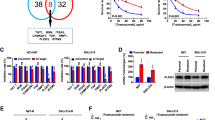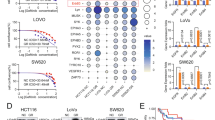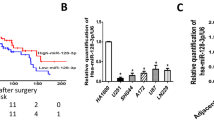Abstract
Gastric cancer is the fifth most common malignancy in the world, with Eastern Asia as one of areas with the highest incidence rates. Trastuzumab, a HER2-targeting antibody, combined with chemotherapy has been successfully employed for the gastric cancer patients with HER2 overexpression/amplification. However, trastuzumab resistance is a major problem in clinical practice. Here we observed that the trastuzumab-resistant gastric cancer cell line NCI-N87/TR expressed high levels of epithelial–mesenchymal transition factors and demonstrated increased migration and invasion capability compared with NCI-N87 cells. Downregulated E-cadherin and increased N-cadherin, TGF-β, ZEB1, ZEB2, TWIST1, and Snail were detected in NCI-N87/TR cells. We also found that miR-200c was downregulated in NCI-N87/TR cells compared with parental cells NCI-87 by qRT-PCR. Treatment with TGF-β downregulated the expression of miR-200c and upregulated ZEB2, and significantly decreased the trastuzumab sensitivity of NCI-N87 cells. miR-200c restored trastuzumab sensitivity and inhibited migration and invasion through suppressing ZEB1 and ZEB2. In summary, TGF-β/ZEB2 axis plays an encouraging role in trastuzumab resistance of gastric cancer, while miR-200c overexpression downregulates ZEB1/ZEB2 and resensitizes drugs resistance. Our findings might provide a potential therapeutic strategy for trastuzumab resistance of gastric cancer.
This is a preview of subscription content, access via your institution
Access options
Subscribe to this journal
Receive 12 print issues and online access
$259.00 per year
only $21.58 per issue
Buy this article
- Purchase on Springer Link
- Instant access to full article PDF
Prices may be subject to local taxes which are calculated during checkout




Similar content being viewed by others
Change history
22 October 2020
The original version of this Article contained inaccuracies in Fig. 2a and 4d (one micrograph has been duplicated and presented as something else), Fig. 2b and 4c (one micrograph has been duplicated and presented as something else) and Fig 3b and 4j (the two beta-actin bands are more similar than you would expect). All figures have been corrected in both the PDF and HTML versions of the Article.
Figure 4d: A large number of wound-healing assays graphs were taken, and had been taken as the cell control for the NCI-N87 ( NCI-N87 and NCI-N87 NC), however there was negligence and repetition in the naming of the pictures. Therefore, these eventually led to the wrong insertion of the image when the authors prepared the figures. One image was repeated in Figure 2A and Figure 4D. Figure 4D has been corrected.
Figure 4c: Due to a large number of invasion assay photos taken and similarity of images, there was an error during image selection when the authors prepared the figure. The NCI-N87 results were used in NCI-N87-200c inhibitors group. One micrograph in Figure 2C and Figure 4C has been duplicated. Figure 4C has been corrected.
Figures 3b and 4j: The two beta-actin bands in Figure 3B and Figure 4J were very similar. We provided the original image. The extreme similarity of the bands does raise doubts. Therefore, the authors have provided two other images and modified Figure 3B and Figure 4J to eliminate these doubts.
05 November 2020
An amendment to this paper has been published and can be accessed via a link at the top of the paper.
References
Torre LA, Bray F, Siegel RL, Ferlay J, Lortet-Tieulent J, Jemal A. Global cancer statistics, 2012. CA Cancer J Clin. 2015;65:87–108.
Ferlay J, Soerjomataram I, Dikshit R, Eser S, Mathers C, Rebelo M, et al. Cancer incidence and mortality worldwide: Sources, methods and major patterns in GLOBOCAN 2012. Int J Cancer. 2015;136:E359–386.
Apicella M, Corso S, Giordano S. Targeted therapies for gastric cancer: failures and hopes from clinical trials. Oncotarget. 2017;8:57654–57669.
Shah MA, Kelsen DP. Gastric cancer: a primer on the epidemiology and biology of the disease and an overview of the medical management of advanced disease. J Natl Compr Canc Netw. 2010;8:437–447.
Cappellesso R, Fassan M, Hanspeter E, Bornschein J, d’Amore ES, Cuorvo LV, et al. HER2 status in gastroesophageal cancer: a tissue microarray study of 1040 cases. Hum Pathol. 2015;46:665–672.
Albarello L, Pecciarini L, Doglioni C. HER2 testing in gastric cancer. Adv Anat Pathol. 2011;18:53–59.
Bang YJ, Van Cutsem E, Feyereislova A, Chung HC, Shen L, Sawaki A, et al. Trastuzumab in combination with chemotherapy versus chemotherapy alone for treatment of HER2-positive advanced gastric or gastro-oesophageal junction cancer (ToGA): a phase 3, open-label, randomised controlled trial. Lancet. 2010;376:687–697.
Shimoyama S. Unraveling trastuzumab and lapatinib inefficiency in gastric cancer: future steps (Review). Mol Clin Oncol. 2014;2:175–181.
Madrid-Paredes A, Cañadas-Garre M, Sánchez-Pozo A, Calleja-Hernández MÁ. Non-HER2 signaling pathways activated in resistance to anti-HER2 therapy in breast cancer. Breast Cancer Res Treat. 2015;153:493–505.
Wilks ST. Potential of overcoming resistance to HER2-targeted therapies through the PI3K/Akt/mTOR pathway. Breast. 2015;24:548–55.
Gerson JN, Skariah S, Denlinger CS, Astsaturov I. Perspectives of HER2-targeting in gastric and esophageal cancer. Expert Opin Investig Drugs. 2017;26:531–540.
Zuo Q, Liu J, Zhang J, Wu M, Guo L, Liao W. Development of trastuzumab-resistant human gastric carcinoma cell lines and mechanisms of drug resistance. Sci Rep. 2015;5:11634.
Piro G, Carbone C, Cataldo I, Di Nicolantonio F, Giacopuzzi S, Aprile G, et al. An FGFR. Autocrine loop sustains acquired resistance to trastuzumab in gastric cancer patients. Clin Cancer Res. 2016;22:6164–6175.
Arienti C, Zanoni M, Pignatta S, Del Rio A, Carloni S, Tebaldi M, et al. Preclinical evidence of multiple mechanisms underlying trastuzumab resistance in gastric cancer. Oncotarget. 2016;7:18424–18439.
Korkaya H, Kim GI, Davis A, Malik F, Henry NL, Ithimakin S, et al. Activation of an IL6 inflammatory loop mediates trastuzumab resistance in HER2 + breast cancer by expanding the cancer stem cell population. Mol Cell. 2012;47:570–584.
Jiang T, Dong P, Li L, Ma X, Xu P, Zhu H et al. MicroRNA-200c regulates cisplatin resistance by targeting ZEB2 in human gastric cancer cells. Oncol Rep. 2017;38:151–158.
Sato H, Shien K, Tomida S, Okayasu K, Suzawa K, Hashida S, et al. Targeting the miR-200c/LIN28B axis in acquired EGFR-TKI resistance non-small cell lung cancer cells harboring EMT features. Sci Rep. 2017;7:40847.
Pan Q, Meng L, Ye J, Wei X, Shang Y, Tian Y, et al. Transcriptional repression of miR-200 family members by Nanog in colon cancer cells induces epithelial-mesenchymal transition (EMT). Cancer Lett. 2017;392:26–38.
Bai WD, Ye XM, Zhang MY, Zhu HY, Xi WJ, Huang X, et al. MiR-200c suppresses TGF-β signaling and counteracts trastuzumab resistance and metastasis by targeting ZNF217 and ZEB1 in breast cancer. Int J Cancer. 2014;135:1356–1368.
Wang X, Du Q, Mao Z, Fan X, Hu B, Wang Z et al. Combined treatment with artesunate and bromocriptine has synergistic anticancer effects in pituitary adenoma cell lines. Oncotarget. 2017;8:45874–45887.
Fujita T, Doihara H, Kawasaki K, Takabatake D, Takahashi H, Washio K, et al. PTEN activity could be a predictive marker of trastuzumab efficacy in the treatment of ErbB2-overexpressing breast cancer. Br J Cancer. 2006;94:247–252.
Zhou X, Wang Y, Shan B, Han J, Zhu H, Lv Y, et al. The downregulation of miR-200c/141 promotes ZEB1/2 expression and gastric cancer progression. Med Oncol. 2015;32:428.
Zhou X, Sang M, Liu W, Gao W, Xing E, Lü W et al. LMO4 inhibits p53-mediated proliferative inhibition of breast cancer cells through interacting p53. Life Sci. 2012;91:358–363.
J Jensen DH, Dabelsteen E, Specht L, Fiehn AM, Therkildsen MH, Jønson L, et al. Molecular profiling of tumour budding implicates TGFβ-mediated epithelial-mesenchymal transition as a therapeutic target in oral squamous cell carcinoma. J Pathol. 2015;236:505–516.
Ock CY, Lee KW, Kim JW, Kim JS, Kim TY, Lee KH, et al. Optimal patient selection for trastuzumab treatment in HER2-positive advanced gastric cancer. Clin Cancer Res. 2015;21:2520–2529.
Jørgensen JT. Targeted HER2 treatment in advanced gastric cancer. Oncology. 2010;78:26–33.
Gomez-Martín C, Lopez-Rios F, Aparicio J, Barriuso J, García-Carbonero R, Pazo R, et al. A critical review of HER2-positive gastric cancer evaluation and treatment: from trastuzumab, and beyond. Cancer Lett. 2014;351:30–40.
Hsieh AC, Moasser MM. Targeting HER proteins in cancer therapy and the role of the non-target HER3. Br J Cancer. 2007;97:453–457.
Mir N, Jayachandran A, Dhungel B, Shrestha R, Steel JC. Epithelial-to-Mesenchymal Transition: a Mediator of Sorafenib Resistance in Advanced Hepatocellular Carcinoma. Curr Cancer Drug Targets. 2017;17:698–706.
Voon DC, Huang RY, Jackson RA, Thiery JP. The EMT spectrum and therapeutic opportunities. Mol Oncol. 2017;11:878–891.
Mongroo PS, Rustgi AK. The role of the miR-200 family in epithelial-mesenchymal transition. Cancer Biol Ther. 2010;10:219–222.
Acknowledgements
This study was supported by Key Project of Health and Family Planning Commission of Hebei Province (No: 20170150) and Hebei Science and Technology project (No: 162777138). We thank Dr. Nathanael Herz Green from Baylor College of Medicine for proofreading and critical comments on the manuscript.
Author information
Authors and Affiliations
Corresponding author
Ethics declarations
Conflict of interest
The authors declare that they have no conflict of interest.
Additional information
Publisher’s note: Springer Nature remains neutral with regard to jurisdictional claims in published maps and institutional affiliations.
Electronic supplementary material
Rights and permissions
About this article
Cite this article
Zhou, X., Men, X., Zhao, R. et al. miR-200c inhibits TGF-β-induced-EMT to restore trastuzumab sensitivity by targeting ZEB1 and ZEB2 in gastric cancer. Cancer Gene Ther 25, 68–76 (2018). https://doi.org/10.1038/s41417-017-0005-y
Received:
Revised:
Accepted:
Published:
Issue Date:
DOI: https://doi.org/10.1038/s41417-017-0005-y
This article is cited by
-
Correlation of PTEN signaling pathway and miRNA in breast cancer
Molecular Biology Reports (2024)
-
Transcription factors in fibroblast plasticity and CAF heterogeneity
Journal of Experimental & Clinical Cancer Research (2023)
-
TGF-β Signaling Activation Confers Anlotinib Resistance in Gastric Cancer
Pharmaceutical Research (2023)
-
The role of the ZEB1–neuroinflammation axis in CNS disorders
Journal of Neuroinflammation (2022)
-
miRNAs derived from plasma small extracellular vesicles predict organo-tropic metastasis of gastric cancer
Gastric Cancer (2022)



